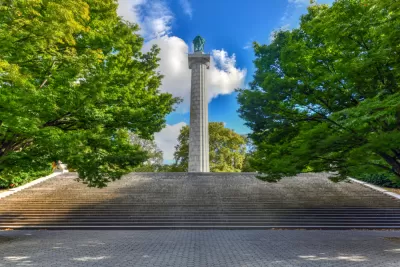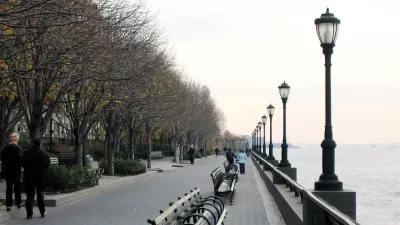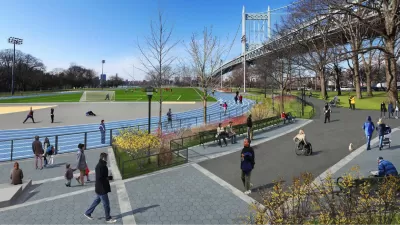The Parks Without Borders program in New York City is intended to open parks to the rest of the public realm, but some local activists like their parks just how they are.

Design changes proposed for Fort Greene Park in Brooklyn are creating controversy for the New York City Parks Department's "Parks Without Borders" program, according to an article by Kendra Hurley.
Parks Commissioner Mitchell Silver told Planetizen in an interview published earlier this year that the Parks Without Borders program is "removing fences, opening up sight-lines, breaking down walls, and converting sidewalks and streets next to parks into plazas."
The changes proposed for Fort Greene Park under the auspices of the program are too radical for a local organization called Friends of Fort Greene Park. Their complaint: that "the bulk of the redesign dishonors the historic vision of the park’s creators, Frederick Law Olmstead and Calvert Vaux, as well as the wishes of those who use this part of the park most, and especially the residents living in the housing developments across the street."
Rachel Sugar reported similar controversy with the same park and the same program in 2017, but Hurley suggests that the controversy with the Parks Without Borders program is not isolated to Fort Greene Park. "In a handful of other neighborhoods slated to receive the Parks Without Borders treatment, the program has been rife with controversy, inspiring some community members to rally in protest of proposed plans, but sometimes finding they have little recourse to stop them," according to Hurley.
The article includes a lot more context, in the form of anecdotes from activists in neighborhoods where the Parks Without Borders program has attempted parks redesigns.
FULL STORY: NYC ‘Parks Without Borders’ program draws controversy

Alabama: Trump Terminates Settlements for Black Communities Harmed By Raw Sewage
Trump deemed the landmark civil rights agreement “illegal DEI and environmental justice policy.”

Study: Maui’s Plan to Convert Vacation Rentals to Long-Term Housing Could Cause Nearly $1 Billion Economic Loss
The plan would reduce visitor accommodation by 25% resulting in 1,900 jobs lost.

Why Should We Subsidize Public Transportation?
Many public transit agencies face financial stress due to rising costs, declining fare revenue, and declining subsidies. Transit advocates must provide a strong business case for increasing public transit funding.

Paris Bike Boom Leads to Steep Drop in Air Pollution
The French city’s air quality has improved dramatically in the past 20 years, coinciding with a growth in cycling.

Why Housing Costs More to Build in California Than in Texas
Hard costs like labor and materials combined with ‘soft’ costs such as permitting make building in the San Francisco Bay Area almost three times as costly as in Texas cities.

San Diego County Sees a Rise in Urban Coyotes
San Diego County experiences a rise in urban coyotes, as sightings become prevalent throughout its urban neighbourhoods and surrounding areas.
Urban Design for Planners 1: Software Tools
This six-course series explores essential urban design concepts using open source software and equips planners with the tools they need to participate fully in the urban design process.
Planning for Universal Design
Learn the tools for implementing Universal Design in planning regulations.
Smith Gee Studio
Alamo Area Metropolitan Planning Organization
City of Santa Clarita
Institute for Housing and Urban Development Studies (IHS)
City of Grandview
Harvard GSD Executive Education
Toledo-Lucas County Plan Commissions
Salt Lake City
NYU Wagner Graduate School of Public Service




























